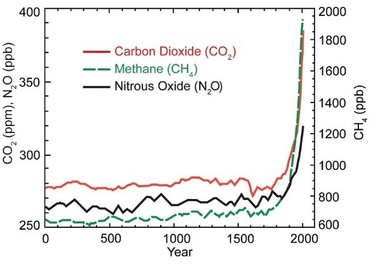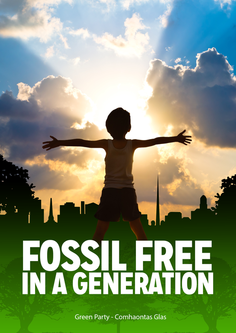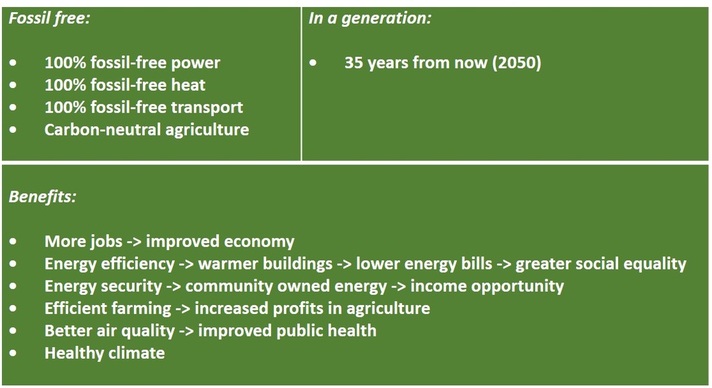 EPA.gov - GHG concent. in atmosphere from Yr 0 to 2000. Exponential increases of these GHGs began during the industrial revolution (1750-1850).
EPA.gov - GHG concent. in atmosphere from Yr 0 to 2000. Exponential increases of these GHGs began during the industrial revolution (1750-1850). The problem starts with the fact that our economic prosperity is historically linked to greenhouse gas production. The industrial revolution (from 1750) was a period of radical technological change, which fuelled economic growth while simultaneously increasing the amount of greenhouse gas (GHG) in our atmosphere leading to climate change. Wealthy countries continue to base their economies on relatively cheap, carbon-intensive energy sources (e.g. coal, oil / fossil fuels). It seems futile to try to reduce GHG emissions without tackling this dependency on carbon-based energy for economic growth.
If you read the list of Ireland’s efforts to reduce our GHG emissions in my last climate FAQ, you’ll notice everything we have done to date has only slightly modified the existing system. We’ve chipped away at converting some of our carbon-based energy production to renewables, but we’re still a heavily carbon-dependent society. Our efforts to reduce emissions in transport have only pushed consumers to purchase more efficient, but still carbon-fuelled, vehicles. Our efforts to reduce GHG emissions have been constrained by our need for continued economic growth in a carbon-based economy. Without a seismic shift away from a carbon-based energy system and towards a fossil-free system, we are beating a dead horse with meagre actions that will not be enough to halt runaway climate change.

This week, Ireland’s Green Party is announcing its “Fossil Free in a generation” campaign. It’s ambitious - I love this kind of visionary thinking, and I know that this concept would transform Ireland into the clean climate leader it needs to become, not only to help solve climate change but also to remove our dependency on imported, insecure, and unsustainable fuel sources. There will be those that doubt “Fossil Free in a generation” is possible – Is it pie-in-the-sky thinking or something that can actually be achieved in Ireland? I needed evidence to find out if this is Ireland’s solution to climate change.
What does “fossil free in a generation” mean?
It sounds idyllic, but can “fossil free in a generation” really happen in Ireland?
At present, Ireland’s fuel mix for electricity generation is dominated by fossil fuels (83%), including gas (48%), coal (22%), peat (12%) and oil (1%). It may seem like an impossible task to convert 83% of fossil fuels to renewable fuels for energy production by 2050, but here’s the reality:
- SEAI’s wind energy roadmap demonstrates that Ireland has the potential to produce enough electricity from wind to exceed domestic demand by 2030.
- The National Economic and Social Research Council’s 2012 report confirms that a fully decarbonised Irish energy system built on wind and other renewables can be achieved by 2050 by developing a smart grid in Ireland and integrating this into a clean EU energy system.
- The EU energy roadmap for 2050 calls for a nearly zero-carbon power supply by 2050 through use of existing technologies to change the way energy is both used and produced.
Such a large transformation in our energy sector won’t be easy. It requires moving investments and subsidies away from fossil fuels and into renewable energy sources and smart grid infrastructure, but the long term benefits in lowering energy costs and improving our energy security would be worth the effort and investment. Ireland has already agreed to be part of Europe’s zero carbon electricity power system by signing the 2030 policy framework for climate and energy. However, in order for this transition to begin, decarbonisation of our energy supply needs to be a core objective of the DCENR Energy White Paper to be published in September, 2015.
Fossil-free heat
We heat our homes and buildings in Ireland using a wide variety of fuels, including solid fuels (turf, wood, coal), oil, gas, and electricity. With the exception of renewable electricity, all these fuels are carbon-based and thus emit greenhouse gases when burned. There are a many things we could do to make the heating systems in new buildings energy efficient and fossil free (e.g. passive construction, solar/geothermal heating, and district heating systems). Our options to retrofit existing buildings for fossil-free heat are more limited, but not unachievable. When combined with energy efficiency improvements such as insulation, it is possible to install heat pumps cost-effectively so heat can be provided by a fossil-free electricity grid. This excellent article from Ireland’s Engineers Journal explains how 100% fossil-free heating is technically possible for Ireland’s new and old building stocks.
Fossil-free transport
At first thought, the idea of a transport system independent of fossil fuels in the next 35 years seemed unrealistic to me. Our government has committed to a target of 10% of vehicles run on electricity by 2020, which they’re unlikely to achieve at present rate. Could we really create a completely fossil-free transport system in 35 years?
In 2008, Min. Simon Coveney (then Fine Gael Energy Spokesperson) claimed that the Fianna Fail-Green Party government goal of 10% electric vehicles by 2020 was under ambitious, and stated it was “both feasible and realistic to aspire to achieve the complete replacement of petrol and diesel engine driven cars with electric vehicles within 15 years”. I couldn’t find evidence to support Min. Coveney’s claim of being able to achieve fossil-free transport in 15 years, but recent peer-reviewed evidence for Ireland demonstrates that we could de-carbonise our transport system within 35 years by replacing 80% of our transport fleet with electric vehicles and powering heavy duty vehicles with biofuels or synthetic fuels. The EU low carbon roadmap aims to undertake a complete transition to hybrid and electric cars and fuel heavy duty vehicles with sustainable biofuels from 2025. While converting our fossil fuel based transport system into a fossil free system seemed unrealistic to me at first, it is technically possible and on its way to becoming a reality at EU level.
Carbon-neutral agriculture
What does carbon-neutral agriculture mean?
The 2012 NESC report defined a carbon-neutral society as one where the net greenhouse gas emissions associated with activities within that society’s geographic area are zero. Teagasc extended this definition to agriculture by defining carbon-neutral agriculture as the “scenario in which national GHG emissions from agriculture are fully offset by carbon sequestration by grassland soils, forestry and other land use”. The NESC Secretariat proposed carbon-neutrality as a ‘horizon point’ for 2050 to which Irish agriculture could aspire.
Is carbon-neutral agriculture possible in Ireland?
Teagasc conducted a qualitative investigation to answer this question in their 2013 report, Carbon Neutrality as a horizon point for Irish Agriculture. They cited a host of uncertainties in future policy and market developments (e.g. price of carbon credits) and in scientific understanding (e.g. how carbon sequestration measures such as afforestation will respond to a changing future climate), all of which prohibited them from giving a definitive answer to this question. However, nowhere in the report does it state that carbon-neutral agriculture by 2050 is impossible.
What’s noteworthy is that the report emphasises the longer we wait to take action, the more difficult this goal of carbon-neutrality will be to achieve, and “even with the uncertainties surrounding the policy and economic landscapes between now and 2050, an ‘early start’ on the pathway towards carbon neutrality will be required”. For example, the report cites the need for immediate action to develop a substantial forestry sink as a cost-effective mitigation measure for the future.
The most encouraging part of the Teagasc report is their conclusion that implementing the concept of carbon neutrality in Irish agriculture “allows a significant expansion in the potential and positive contribution that agriculture can make” to reducing national GHG emissions. In their words, “full carbon-neutrality for agriculture by 2050 may be difficult to achieve, but this should not distract from efforts to approach carbon-neutrality as a horizon point.” Even aspiring toward carbon-neutrality in agriculture would make a significant difference in our country’s GHG emissions.
Is “fossil free in a generation” Ireland’s solution to climate change?
When I began this post, I was sceptical that the “fossil free in a generation” concept was a realistic solution to combat climate change in Ireland. However, when I broke it down into its components, I was surprised how easily I was able to find evidence to demonstrate that a fossil-free society is achievable. It won’t be easy, but the technology to undertake this ambitious transformation already exists and new technologies will continue to develop to expedite the process. The only thing that prevents such a large-scale transformation from happening is political will and the tendency to maintain the status quo rather than tackle long-term challenges.
Green Party critics could claim their “fossil free in a generation” call is an unsubstantiated dream, but this vision is truly possible for Ireland and would undoubtedly revolutionise our society. If we want to live in this fossil-free world and enjoy all the benefits it has to offer, we simply have to elect representatives to carry out our vision.
Keep fighting the good fight!
-Cara



 RSS Feed
RSS Feed
